https://kinescopedreams.blogspot.com/2015/03/woody-strode-and-michael-pate-one.html
This article is about a few of my favorite appearance by one of those "faces". Who was a Rodeo Champion and part of "The John Ford Stock Company". Along with taking home a Best Supporting Oscar for a part he did not want to play in Peter Bogdanovich's 1971 "The Last Picture Show"..
Ben Johnson, Junior, was born on the Osage Indian Reservation in Foraker, Oklahoma, June 13, 1918. His mother was Ollie Susan Johnson and his father Ben Johnson, Senior. The future actor was half Irish and half Osage Indian. He was known not as "Junior", but as Ben "Son" Johnson. His father was both a rancher and manager of a larger ranch. The future actor's father appeared at Oklahoma rodeo's and become a local champion. The "Son" would follow in his father footsteps prior to becoming an actor
According to all sources Ben "Son" Johnson came indirectly to Hollywood for the first time in 1940. When he brought horses from the ranch his father was managing to Arizona for a film shoot and found work as a stunt double. Depending on the version of this story. The purchase agreement for the horses was either with the motion picture's producer Howard Hughes, or director Howard Hawks. The film was Hughes' controversial Western about Billy the Kid "The Outlaw" released by RKO.
However, it is a fact that Ben "Son" Johnson appeared without screen credit as a "Mexican Barfly"and stunt man in the George O'Brien Western "The Fighting Gringo". A motion picture that was released August 8, 1939. So how could the above story be true, if Johnson had already appeared the O'Brien picture? The only answer is that the horses were not brought for "The Outlaw", but the earlier 1939 production. Also released by RKO. Although Johnson's association with Howard Hughes' Western makes a better back story.
In 1941 Ben Johnson married Carol Elaine Jones and the two would be together until her death in 1994. They had no children.
After "The Fighting Gringo" Ben Johnson's work was only as a stunt double, or horse and cattle wrangler. This began with doubling Western star Charles Starlett in 1940's "The Durango Kid" and lasted for 10 motion pictures, including "The Outlaw" and "Tarzan's Desert Mystery", through doubling Russell Hayden in 1943's "Riders of the Northwest Mounted", This work was followed starting in 1943's "Bordertown Gun Fighters" with 8 motion picture non-screen credited "walk om" acting appearances, while still performing stunt work, through 1948's "The Gallant Legion".
Bringing me to another of those stories about how Ben "Son" Johnson became an actor. In this case there is no confusion over the story and it is told by many including his friend actor Harry Carey, Jr. in "Company of Heroes: My Life with the John Ford Stock Company". A very good book for fans of Ford's work.
At the time Ben Johnson was working as a wrangler on the 1948 John Ford production "Fort Apache" starring John Wayne, Henry Fonda, Shirley Temple and introducing actor John Agar. Agar would marry Temple shortly after the pictures completion. You can read about John Agar's rise, fall and come back as a 1950's/1960's Science Fiction icon at this link to my blog article on him:
https://kinescopedreams.blogspot.com/2015/03/john-agar-his-fall-that-led-to-science.html
Director John Ford was filming a sequence of "Fort Apache" involving three people on a wagon. Johnson and another wrangler were watching the shoot. When suddenly the horses spooked and the wagon became an unplanned and very real run-a-way. Ben Johnson realizing what he was seeing went after the wagon as the cameras still rolled and was able to stop the horses and save the actors from injury.
Ford said he had a special reward for the wrangler/stunt man. Johnson thought it might be some extra stunt work by doubling the main actors for a higher pay, or even a walk on speaking role. Instead, Ben "Son" Johnson was shocked when he was offered a $5,000 a week seven year exclusive contract to John Ford.
Ben Johnson, actor, found his first screen credited role as "Posse Man #1" in Ford's classic 1949 remake of his own "The 3 Godfathers". This time starring John Wayne, Pedro Armendaiz and introducing Harry Carey, Jr. This was followed once again by without screen credited stunt work on Howard Hawks' "Red River" starring John Wayne and Montgomery Cliff from United Artists and an MGM musical "The Kissing Bandit" starring a young Frank Sinatra.
This might not have seemed a great beginning for a fledgling character actor. Who would end his career with 103 appearances in either motion pictures or television, but you have to start somewhere.
I am not going into detail on all 103 appearances of Ben "Son" Johnson, but only 9 motion pictures. Along with one character he created. A role he is forever associated with when John Ford directed Westerns are mentioned. The first of the 9 pictures and the creation of that character still took place in the very productive year of 1949. Should you be interested here is a link to the IMDb list of Ben Johnson's total work:
http://www.imdb.com/name/nm0424565/
That first of the 9 films I want to discuss in detail put Ben Johnson in the company of one of the largest actors (?) in film history, The title character "Mighty Joe Young". The movie would also be known as "Mr. Joseph Young of Africa" and "The Great Joe Young" depending on which country it was shown in.

This film starred Terry Moore. Who at the time of its release was the girlfriend of the current owner of RKO Pictures Howard Hughes. Ben Johnson had second billing and the film featured Robert Armstrong doing what was a comic version of his role of Carl Denham from the 1933 "King Kong".
Although Merian C. Cooper, the creator of "King Kong", was head of RKO's production and this was a pet project of his. The credits for the motion picture show his good friend and co-producer John Ford first. The two would make several classic John Wayne films together as "Argosy Pictures". "Mighty Joe Young" was also directed by Cooper's long time partner from before their 1933 "King Kong" Ernest B. Schoedsack.
For a look at the remarkable, almost Hollywood written, life of Merian C. Cooper. Here is a link to my article:
https://kinescopedreams.blogspot.com/2015/10/merian-c-cooper-before-king-kong-to.html
"Mighty Joe Young" would be released on July 27, 1949, but the work on the animated effects started in 1947 with the hiring of Ray Harryhausen as Willis O'Brien's assistant. The movie would win an Oscar for producer Merian C. Cooper for the special effects, but it should be noted it was only up against only one other motion picture. A Susan Hayward, Robert Preston film "Tulsa" revolving around the Tulsa, Oklahoma 1920's oil boom.
Ben Johnson played "Gregg", no last name ever given, a wrangler for Max O'Hara, Robert Armstrong, who is capturing wild animals in Africa for his New York Restaurant. The two come in contact with Jill Young and her pet 12 foot high gorilla Joe.
According to all sources Ben "Son" Johnson came indirectly to Hollywood for the first time in 1940. When he brought horses from the ranch his father was managing to Arizona for a film shoot and found work as a stunt double. Depending on the version of this story. The purchase agreement for the horses was either with the motion picture's producer Howard Hughes, or director Howard Hawks. The film was Hughes' controversial Western about Billy the Kid "The Outlaw" released by RKO.
However, it is a fact that Ben "Son" Johnson appeared without screen credit as a "Mexican Barfly"and stunt man in the George O'Brien Western "The Fighting Gringo". A motion picture that was released August 8, 1939. So how could the above story be true, if Johnson had already appeared the O'Brien picture? The only answer is that the horses were not brought for "The Outlaw", but the earlier 1939 production. Also released by RKO. Although Johnson's association with Howard Hughes' Western makes a better back story.
In 1941 Ben Johnson married Carol Elaine Jones and the two would be together until her death in 1994. They had no children.
After "The Fighting Gringo" Ben Johnson's work was only as a stunt double, or horse and cattle wrangler. This began with doubling Western star Charles Starlett in 1940's "The Durango Kid" and lasted for 10 motion pictures, including "The Outlaw" and "Tarzan's Desert Mystery", through doubling Russell Hayden in 1943's "Riders of the Northwest Mounted", This work was followed starting in 1943's "Bordertown Gun Fighters" with 8 motion picture non-screen credited "walk om" acting appearances, while still performing stunt work, through 1948's "The Gallant Legion".
Bringing me to another of those stories about how Ben "Son" Johnson became an actor. In this case there is no confusion over the story and it is told by many including his friend actor Harry Carey, Jr. in "Company of Heroes: My Life with the John Ford Stock Company". A very good book for fans of Ford's work.
At the time Ben Johnson was working as a wrangler on the 1948 John Ford production "Fort Apache" starring John Wayne, Henry Fonda, Shirley Temple and introducing actor John Agar. Agar would marry Temple shortly after the pictures completion. You can read about John Agar's rise, fall and come back as a 1950's/1960's Science Fiction icon at this link to my blog article on him:
https://kinescopedreams.blogspot.com/2015/03/john-agar-his-fall-that-led-to-science.html
Director John Ford was filming a sequence of "Fort Apache" involving three people on a wagon. Johnson and another wrangler were watching the shoot. When suddenly the horses spooked and the wagon became an unplanned and very real run-a-way. Ben Johnson realizing what he was seeing went after the wagon as the cameras still rolled and was able to stop the horses and save the actors from injury.
Ford said he had a special reward for the wrangler/stunt man. Johnson thought it might be some extra stunt work by doubling the main actors for a higher pay, or even a walk on speaking role. Instead, Ben "Son" Johnson was shocked when he was offered a $5,000 a week seven year exclusive contract to John Ford.
Ben Johnson, actor, found his first screen credited role as "Posse Man #1" in Ford's classic 1949 remake of his own "The 3 Godfathers". This time starring John Wayne, Pedro Armendaiz and introducing Harry Carey, Jr. This was followed once again by without screen credited stunt work on Howard Hawks' "Red River" starring John Wayne and Montgomery Cliff from United Artists and an MGM musical "The Kissing Bandit" starring a young Frank Sinatra.
This might not have seemed a great beginning for a fledgling character actor. Who would end his career with 103 appearances in either motion pictures or television, but you have to start somewhere.
I am not going into detail on all 103 appearances of Ben "Son" Johnson, but only 9 motion pictures. Along with one character he created. A role he is forever associated with when John Ford directed Westerns are mentioned. The first of the 9 pictures and the creation of that character still took place in the very productive year of 1949. Should you be interested here is a link to the IMDb list of Ben Johnson's total work:
http://www.imdb.com/name/nm0424565/
That first of the 9 films I want to discuss in detail put Ben Johnson in the company of one of the largest actors (?) in film history, The title character "Mighty Joe Young". The movie would also be known as "Mr. Joseph Young of Africa" and "The Great Joe Young" depending on which country it was shown in.

This film starred Terry Moore. Who at the time of its release was the girlfriend of the current owner of RKO Pictures Howard Hughes. Ben Johnson had second billing and the film featured Robert Armstrong doing what was a comic version of his role of Carl Denham from the 1933 "King Kong".
Although Merian C. Cooper, the creator of "King Kong", was head of RKO's production and this was a pet project of his. The credits for the motion picture show his good friend and co-producer John Ford first. The two would make several classic John Wayne films together as "Argosy Pictures". "Mighty Joe Young" was also directed by Cooper's long time partner from before their 1933 "King Kong" Ernest B. Schoedsack.
For a look at the remarkable, almost Hollywood written, life of Merian C. Cooper. Here is a link to my article:
https://kinescopedreams.blogspot.com/2015/10/merian-c-cooper-before-king-kong-to.html
"Mighty Joe Young" would be released on July 27, 1949, but the work on the animated effects started in 1947 with the hiring of Ray Harryhausen as Willis O'Brien's assistant. The movie would win an Oscar for producer Merian C. Cooper for the special effects, but it should be noted it was only up against only one other motion picture. A Susan Hayward, Robert Preston film "Tulsa" revolving around the Tulsa, Oklahoma 1920's oil boom.
Ben Johnson played "Gregg", no last name ever given, a wrangler for Max O'Hara, Robert Armstrong, who is capturing wild animals in Africa for his New York Restaurant. The two come in contact with Jill Young and her pet 12 foot high gorilla Joe.
There is a sequence were Joe lets loose some animals and Ben Johnson and other cowboys attempt to rope him, This is the first time a major movie attempted part of Willis O'Brien's "Gwangi" story line that Willis O'Brien would reuse in 1956's "The Beast of Hollow Mountain" and animator Ray Harryhausen would turn into the 1969 film "The Valley of Gwangi". Below is a still of a stop motion version of Ben Johnson attempting to rope Joe. Harryhausen weaved live action shots of the actor with his stop motion double.

Fast talking O'Hara convinces Jill, who has never left Tanganyika, to come to New York with Joe. Where "King Kong" was billed as "The Eighth Wonder of the World". Merian C. Cooper has Joe billed as "Mr Joseph Young of Africa". From their first meeting Gregg and Jill begin to fall in love and he is against taking the Gorilla and the girl out of Africa, but O'Hara wins.

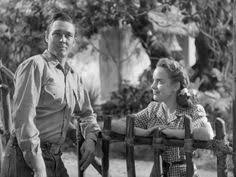
The film contains some great special effects moments. Such as Terry Moore playing Joe's favorite song "Beautiful Dreamer" on a piano as she moves upwards being held by the gorilla.
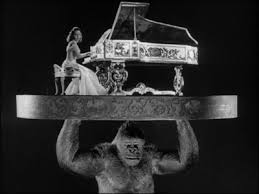
The trouble Gregg feared occurred as a group of drunken patrons get the gorilla drunk. He gets out of his cage and destroys the night club. The police are given a ruling from a Judge to kill Joe Young, but O'Hara helps Gregg and Jill free him. Joe is placed in the back of a moving van to hide him from view.
As they escape and race with the police in pursuit for a ship that will take the three back to Africa. They come upon a fire at an orphanage.
The sequence of Joe saving orphans as the orphanage burns is considered a classic of stop motion animation and one of the reasons for the film's Oscar. Cooper did the right thing and represented it to Willis O'Brien. As at the time only the producer could receive credit for that work.




Jill, Gregg and Joe at the end of the film. The shot shows a very relaxed Johnson. Although Howard Hughes was on the set daily watching over Terry Moore.
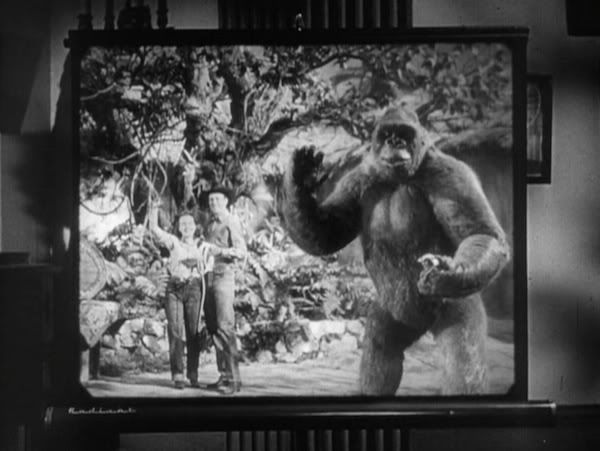
On July 26, 1949 the day before the release of "Mighty Joe Young". RKO pictures had a special preview showing of John Ford's "She Wore A Yellow Ribbon" in Kansas City, Kansas, The second part of John Ford's Calvary Trilogy was also co-produced by Merian C. Cooper for Argosy Pictures. The general release wasn't until October 22, 1949.
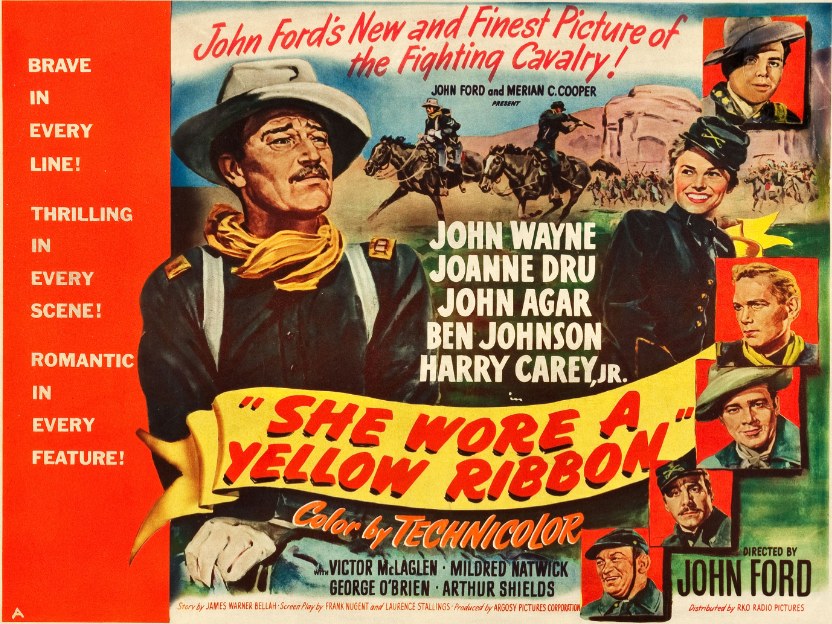
As to which motion picture completed shooting first I could not locate. but Ben Johnson created my favorite of all his character's Sergeant Tyree in this film.

Johnson's laid back style made Chief Scout Sergeant Tyree so memorable in"She Wore A Yellow Ribbon". In the story Tyree is scouting a break out of Cheyenne and Arapaho's from the reservation. Along with Captain Brittles, John Wayne, the two go to the Indian camp and confront Red Shirt, Noble Johnson, and his warriors young and old. The picture's screen credit gives Ben Johnson fourth billing under Wayne, Joanne Dru and John Agar.
The following year saw the release of the Third Picture of the Calvary Trilogy in the Argosy production of "Rio Grande", Ben"Son Johnson" had moved up to third billing behind John Wayne and Maureen O'Hara.

The story is set years before "She Wore A Yellow Ribbon" and Tyree is just one of a group of new Troopers. As is Daniel "Sandy" Boone played by Harry Carey, Jr. There is a great early scene showing off the riding skills of both actors. When they actually ride Roman Style around the inner Fort. After Sgt, Major Quincannon, Victor McLaglen, asks the recruits, if any can actually ride a horse.


It is during the action of "Rio Grande" that the background of the future Sgt. Tyree is confirmed as a former Captain in the Confederate Army. In this movie we see the start of the relationship between Ben Johnson's Tyree and John Wayne's Calvary Officer that was reflected in the previous motion picture.
That Calvary Officer is of interest to the continuity of what was John Ford's unplanned Calvary Trilogy.
As I already wrote Ben "Son" Johnson did not act in 1948's "Fort Apache". In it John Wayne played Captain Kirby York and at the end of the film he is promoted to Lieutenant-Colonel. When we meet Sgt. Tyree in 1949's "She Wore A Yellow Ribbon", John Wayne is now playing retiring Captain Nathan Brittles. However, when we learn of Tyree's background in 1950's "Rio Grande". John Wayne once more plays "Captain Kirby Yorke. The last name now spelled with an "E" at the end in the script.
The two motion pictures featuring Ben Johnson appear to follow each other. We meet Mrs. Kirby York, or Yorke in "Rio Grande" and "Trooper" Tyree. While in "She Wore a Yellow Ribbon" we have the promoted and seemingly older Chief Scout Tyree. John Wayne's character is now named Nathan Brittles. We learn he was married and his wife is buried at the fort he has served in for many years. Had Wayne's character's name been either Kirby York, or Kirby Yorke in "She Wore A Yellow Ribbon". You could reverse the order of the three films and almost have a complete look at Wayne's Cavalry Officer since the end of the American Civil War.
It should be remembered that John Ford did not want to make "Rio Grande". Which is why I wrote that the Calvary Trilogy was not a planned grouping, but a deal was struck with Republic Pictures to do the Calvary film in trade for John Ford being able to go to Ireland and film "The Quiet Man". The motion picture he actually wanted to make. So we can speculate that the screenwriter, or perhaps Ford for "Rio Grande" decided to return to the original name of Wayne's character and tie the film to "Fort Apache".
Whatever the answer "Rio Grande" gave Ben Johnson a large amount of screen time with his friend Harry Carey, Jr. and this would lead to a small western overlooked by many starring both men.
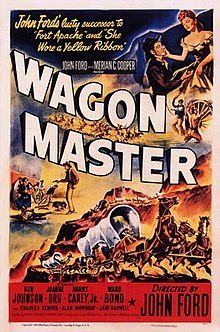
The film is considered one of John Ford's favorites and although it doesn't have the audience popularity of most of Ford's other works. The picture is truly a minor masterpiece of film making and character development.
John Ford's son Patrick wrote the original treatment. With his father the two changed some historic facts to make what critics called a "film poem" concentrating on vistas and panorama's rather than what was expected in a typical 1950 Western. Such as Anthony Mann's "Winchester 73", or Delmer Daves' "Broken Arrow". Both starring James Stewart.
Ford biographer Joseph McBride in his 1975 work "John Ford" wrote:
British Director and film critic Lindsay Anderson in April 1954 wrote:
In "Wagon Master" we have an obvious. but not named Mormon wagon train being lead by Ward Bond's Elder Wiggs. The change here is that unlike real Mormon's who were always heavily armed and ready for a fight. These are pacifists and it is up to the two itinerant horse traders Travis Blue, Ben Johnson, and Sandy Owens, Harry Carey, Jr, to protect them. As Elder Wiggs accepts Travis as their Wagon Master and the man in charge of the journey to the San Juan River country of southeastern Utah.


The problem here is that Travis claims he has only fired a gun at "snakes", a choice of a word with a double meaning in a western, and Sandy has never fired a gun at any other person.
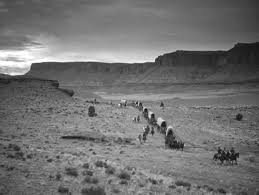
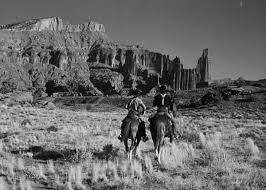
On the trail the wagon train comes across a traveling Medicine show that is trouble. This includes Joanne Dru as Denver, Like the implied Mormons that Travis and Sandy are guiding without mentioning that name. John Ford implies that Denver is really a prostitute by her choice of dress and dialogue without ever using that term to get around the censors. She and Travis over the remaining film will fall in love.

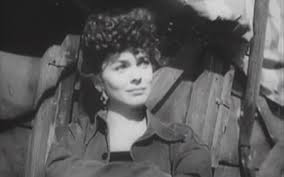
The wagon train meets a group of Navajo Indians, but Ford puts a twist on things and the Indians are friendly and not the aggressors of his other westerns. However, "Wagon Master" has a prologue in which the audience meets the Glegg family of robbers and killers. One of them is played by a pre-"The Thing from Another World", and "Gunsmoke", James Arness. These are the real villains of the piece and it is this family that Ben Johnson and Harry Carey, Jr. must fight and kill in their defense of the wagon train. That prologue being followed by the film's titles make the opening for "Wagon Master" extremely innovative for 1950

For all appearances Ben Johnston was in good form with John Ford. However, Ford was known for his temper and unpredictability. While filming "Rio Grande", Johnson didn't like being browbeaten by Ford, something John Ford was known to do to actors, just ask John Wayne. However, Johnson told the director "to go to hell". A few days later, Ben Johnson had forgotten the incident, but it had set off John Ford. For the next 11 years the director would not use the actor.
His last film appearance before he took a break from motion pictures to compete in "The Professional Rodeo Cowboys Association" was 1953's "Shane. Before Ben Johnson returned to film and also television he became the "Team World Roping Champion".
He returned to motion pictures starting with the 1955 musical "Oklahoma" as an non-screen credited wrangler. The following year with 1956's "A Rebel in Town" saw Ben Johnson once more on screen. Along with his first appearances on television in programs as wide ranging as "The Ozzie and Harriet Show" and "Perry Mason",
On March 31, 1961 the Marlon Brando directed and starring motion picture "One-Eyed Jacks" was released. The early draft of the picture was by Rod Sterling. A non-screen credited writer named Sam Peckinpah worked on the screenplay based upon a novel by Charles Neider "The Authentic Death of Hendry Jones". Which was a name changed tale of Billy the Kid, Peckinpah, himself, would use this novel as one of the basis for "Pat Garrett and Billy the Kid" 12 years later. The script for this motion picture changed Neider's names once more for certain characters including Brando's.
Ben Johnson had fourth billing in the role of Bob Emery. Also spelled Bob Amory.

The part of Bob Emery (Amory) is the complete opposite of either Sgt. Tyree, or Travis Blue for Johnson. He is described as a "snake like scum-suckin' pig" and as played by the actor pure evil under a outgoing disarming personality. Bob uses his knowledge of the whereabouts of Rio's, Brando's Billy the Kid, ex-partner Dad Longworth, Karl Malden's Pat Garrett, to join his gang. Of course Ben Johnson's character has his own agenda.
The motion picture predates the Spaghetti western craze that was to come in its look and style. Along with Johnson the cast included Kathy Jurado as Malden's wife and Slim Pickens as a very sadistic deputy of Longworth. In fact all the characters in the motion picture with the exception of Brando's "Rio" and Mexican actress Pina Pellicer as Dad's daughter Louisa are all "hard cases" as they used to say. All designed to make the audience side with Rio.
Variety at the time of the movies release stated:
I personally enjoyed the film when I first saw it and still do. "One-eyed Jacks" was followed by John Ford's apology to Native American's "Cheyenne Autumn" released October 3, 1964. This was the picture the director let the actor back into his circle. Although John Ford cast Ben "Son" Johnson in the non-screen credited role of Trooper Plumtree.
"Cheyenne Autumn" was a box office flop for Ford and Warner Brothers. The picture was filmed in his favorite background Monument Valley, Utah with Navajo's playing the majority of the Cheyenne's and telling dirty jokes on screen in their native tongue. The lead Native American's were once more, in a film apology to them, played by non-Native American actors. For those interested in how Native American's were portrayed in films from the Silent Era through the 2013 "Lone Ranger" can be found on my blog at:
http://kinescopedreams.blogspot.com/2015/08/native-americans-hollywood-style-i.html
Speaking of Sam Peckinpaw Ben Johnson played a Confederate prisoner in "Major Dundee" starring Charlton Heston and Richard Harris. The first of three of the director's films I want to speak too.

In this epic motion picture Ben Johnson plays Sergeant Chillium described as "the right hand man" of Richard Harris' Confederate officer Captain Benjamin Tyreen.
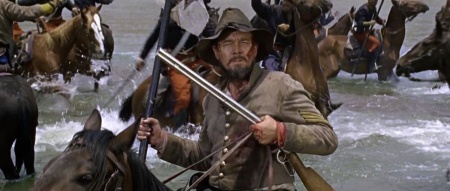


"Major Dundee" was an epic in the true sense. The story takes place during the American Civil War and tells the story of a Union Prison in the New Mexico Territory for Confederate prisoners of war.
To start you have Charlton Heston's title character in charge. Dundee was sent there due to unspecified charges by his superiors against him. You have Harris, a pre-war friend of the Southern born Dundee, Johnson and others retaken after an escape attempt that failed about to be hung, but now needed badly by Dundee. The Apache Chief Sierra Charriba, played by Australian Michael Pate mentioned in my first paragraph, has attacked homesteaders and taken some boys prisoner.
The plot has Dundee following the War Chief and his band illegally into Mexico with a troop made up of Union soldiers both white and black. Using the black prison guards, who have volunteered to finally see some type of action, creates tension with the Confederate Whites. The same Confederate Prisoners who have their own agenda, but a promise from Harris's Captain Tyreen keeps them in line until the Apache's are destroyed and the boys returned. The problem for the group once they gross the Rio Grande is that Mexico is under French rule by Maximilian. Which could possibly mean engaging French troops.
When I first saw this picture in March of 1965 the running time was two hours and three minutes. The music didn't really fit the plot and a theme song for the picture was performed by the then popular "Mitch Miller and His Sing Along Gang".
Not only was that sound track wrong, but Sam Peckinpah hated the released cut which was 29 minutes shorter than the director's cut he presented to the producer Jerry Bressler. I have the restored version on DVD released in April 2005 twenty-one years after the Peckinpah's death. Working from his editing script and searching for lost footage. The restored version is only 13 minutes longer than the theatrical version, because the other 16 minutes are still considered lost.
As with all of Sam Peckinpah's films character development is very important and 10th billed Ben "Son" Johnson is reverting in his performance in this must see, in the restored version, motion picture.
Which brings me to Peckinpah's "The Wild Bunch" and a group of "A" list actors and character actors at their best. The main reason claimed for the cutting of "Major Dundee" was the level of violence and blood shed in it. What a difference four years made.
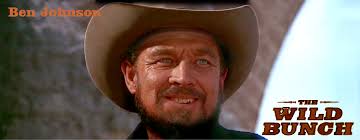
"The Wild Bunch" would not have been made, if William Goldman's script about aging outlaws at the start of the century "Butch Cassidy and the Sundance Kid" hadn't gone into production at 20th Century Fox. Warner Brother-Seven Arts discovered the script for "The Wild Bunch" while looking for a vehicle for Sam Peckinpah to direct. This screenplay about aging outlaws also at the turn of the century was a perfect film with all the pre-publicity the Paul Newman and Robert Redford movie was getting. Peckinpah was instructed to beat the other motion picture to the box office. He did by three months.
Ben Johnson played Tector Gorch part of Pike Bishop's, William Holden's, aging outlaw gang. The year is 1913 and in less than another year World War One will start. The gang who belongs back in the 19th Century wants one last score to retire upon. Pike's choice of a bank robbery goes wrong. In this theme the film parallels "Butch Cassidy and the Sundance Kid" in many respects.
"The Wild Bunch" from the time of the bank robbery is being pursued by Deke Thornton, Robert Ryan. Thornton once rode with Pike and the others. They are all friends facing the end of their lives with nothing to show. Thornton sees the easier route to retirement and a nest egg by going after his old gang. This same theme was reused by Sam Peckinpah with a different approach four years later in "Pat Garrett and Billy the Kid".
"The Wild Bunch" was shocking at the time for its violent, extremely bloody, slow motion death of each of the outlaws, The ending made the motion picture one of the most talked about at the time. The other was "Butch Cassidy and the Sundance Kid" which sets up such an ending for the film's anti-hero's, but lets the viewers imaginations take over by using a freeze frame ending.
.

"The Wild Bunch" was nominated for two Academy Awards: Best Screenplay and Musical Score. It lost to "Butch Cassidy and the Sundance Kid". Sam Peckinpah was one of ten directors nominated for the Directors Guild of America's Award for Outstanding Director---Feature film. Peckinpah lost to John Schlesinger for "Midnight Cowboy". A film about a male prostitute who wears "B" Hollywood Cowboy outfits starring Dustin Hoffman and introducing John Voigt in the title role. It was rated "X" at the time.
Which brings me to the last of the three motion pictures Ben Johnson appeared in for Sam Peckinpah and probably the most appropriate "Junior Bonner". The picture starred Steve McQueen in the title role as a veteran Rodeo competitor. Robert Preston played his father, Ida Lupino his mother, both only 18 years older than McQueen, and Johnson played the owner of the rodeo that we first see in the opening sequence. Junior is injured riding the bull Sunshine and as a result leaves his home of Prescott, Arizona. It is his return that the film deals with as Junior faces his mother and father's problems, his own faults and failures. As he attempts to prove himself by convincing Ben Johnson's, Buck Roan, to let him ride Sunshine one more time.

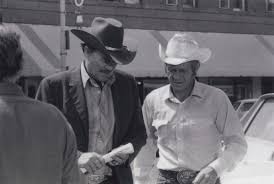

"Junior Bonner" follows one of Peckinpah's favorite themes the end of traditional western life and the change brought on by capitalism.The motion picture's release on August 2, 1972 was ill timed as there was a large amount of Rodeo themed films in theaters. In fact most people didn't see it and the film didn't recover its initial budget. Even after World Wide grosses were counted with United States ticket sales.
Sam Peckinpah would comment:
I enjoy this picture and it was nice to see Ben "Son" Johnson in a Rodeo setting.
The next motion picture I want to mention should have been a small film, but it took off after being released on April 5, 1974. In "The Sugarland Express" Ben Johnson played Department of Public Safety Captain Harlin Tanner. The story is based upon a real life incident that occurred in Sugarland, Texas. The draw was it starred from "Rowan and Martin's Laugh-In" "Sock it to me" girl Goldie Hawn. What wasn't considered by the audience at the time of the picture's original release was the director of the movie. This was his first theatrical feature and his name was Steven Spielberg. The composer was also unknown. His name was John Williams.
Goldie Hawn played Lou Jean Poplin and William Atherton played Clovis Michael Poplin. Clovis has four months left to finish his prison sentence. However, Lou Jean convinces him to escape to rescue their son who was taken away from her and is about to be placed in a foster home.
Ben Johnson played Captain Harlan Tanner who is in charge of the chase of these two who have kidnapped a Highway Patrol Officer and are using him as their driver.
The following is from Roger Ebert's actual 1974 review of this motion picture.

Scottish writer Alistair MacLean is known mostly for his novels and the motion pictures made from some of them, Such as "The Guns of Navarone", "Where Eagles Dare" and "Ice Station Zerbra".In 1974 the author wrote an American Western mystery "Breakheart Pass". In December 1975 the motion picture version with a screenplay also by MacLean was released. The movie starred Charles Bronson as an assumed outlaw captured by Sheriff Pearce portrayed by Ben Johnson. Pearce takes his prisoner on to a train with the Governor played by Richard Crenna and his future wife Maria played by Bronson's wife Jill Ireland. There are others on this train that is heading for Fort Humbolt with medical supplies for a diphtheria outbreak, but nothing is as it seems in this very good but predictable story. One of my favorite Charles Bronson movies. The acting is excellent and the story creates some interesting characters as Bronson uncovers the truth, which the audience has been let in on, as the train nears Breakheart Pass.
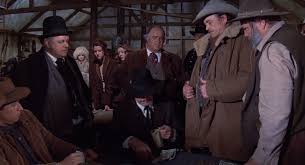
There is nothing like a good slasher/horror movie taking place three years after a College prank gone wrong. Add in that the current action takes place within the confines of a speeding train for a New Years Eve costume party and the fun begins. This is a look at the last motion picture Ben Johnson appeared in that I wanted to mention in this article.
The year was 1980 and "Terror Train" of course starred Jamie Lee Curtis as the innocent girl caught in the mayhem and 62 year old Ben Johnson plays the train's conductor and the film's hero. Adding to the fun is the magician hired to entertain played by a then unknown David Copperfield.

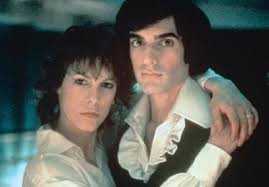
The movie is a lot of bloody/sexy fun as were a lot of films at the time. Ben Johnson is very heroic as the train conductor faced with a series of murders and as always Jamie Lee Curtis was the perfect girl in distress.
Ben "Son" Johnson's career was very varied. The reason I keep bringing up Ben Johnson's nickname is because his ranch in Oklahoma was named "Ben "Son" Johnson's Ranch. Obviously he was very proud of his heritage.
Ben Johnson's wife passed away March 27, 1994. Two years after his wife's passing on April 8. 1996 on a visit to his 96 year mother at Leisure World in Mesa, Arizona. The actor had a heart attack and collapsed. He was 77 years old. His mother would outlive her son and pass away at 101 on October 16, 2000.
Fast talking O'Hara convinces Jill, who has never left Tanganyika, to come to New York with Joe. Where "King Kong" was billed as "The Eighth Wonder of the World". Merian C. Cooper has Joe billed as "Mr Joseph Young of Africa". From their first meeting Gregg and Jill begin to fall in love and he is against taking the Gorilla and the girl out of Africa, but O'Hara wins.
The film contains some great special effects moments. Such as Terry Moore playing Joe's favorite song "Beautiful Dreamer" on a piano as she moves upwards being held by the gorilla.
The trouble Gregg feared occurred as a group of drunken patrons get the gorilla drunk. He gets out of his cage and destroys the night club. The police are given a ruling from a Judge to kill Joe Young, but O'Hara helps Gregg and Jill free him. Joe is placed in the back of a moving van to hide him from view.
As they escape and race with the police in pursuit for a ship that will take the three back to Africa. They come upon a fire at an orphanage.
The sequence of Joe saving orphans as the orphanage burns is considered a classic of stop motion animation and one of the reasons for the film's Oscar. Cooper did the right thing and represented it to Willis O'Brien. As at the time only the producer could receive credit for that work.
Jill, Gregg and Joe at the end of the film. The shot shows a very relaxed Johnson. Although Howard Hughes was on the set daily watching over Terry Moore.

On July 26, 1949 the day before the release of "Mighty Joe Young". RKO pictures had a special preview showing of John Ford's "She Wore A Yellow Ribbon" in Kansas City, Kansas, The second part of John Ford's Calvary Trilogy was also co-produced by Merian C. Cooper for Argosy Pictures. The general release wasn't until October 22, 1949.

As to which motion picture completed shooting first I could not locate. but Ben Johnson created my favorite of all his character's Sergeant Tyree in this film.
Johnson's laid back style made Chief Scout Sergeant Tyree so memorable in"She Wore A Yellow Ribbon". In the story Tyree is scouting a break out of Cheyenne and Arapaho's from the reservation. Along with Captain Brittles, John Wayne, the two go to the Indian camp and confront Red Shirt, Noble Johnson, and his warriors young and old. The picture's screen credit gives Ben Johnson fourth billing under Wayne, Joanne Dru and John Agar.
The following year saw the release of the Third Picture of the Calvary Trilogy in the Argosy production of "Rio Grande", Ben"Son Johnson" had moved up to third billing behind John Wayne and Maureen O'Hara.
The story is set years before "She Wore A Yellow Ribbon" and Tyree is just one of a group of new Troopers. As is Daniel "Sandy" Boone played by Harry Carey, Jr. There is a great early scene showing off the riding skills of both actors. When they actually ride Roman Style around the inner Fort. After Sgt, Major Quincannon, Victor McLaglen, asks the recruits, if any can actually ride a horse.
It is during the action of "Rio Grande" that the background of the future Sgt. Tyree is confirmed as a former Captain in the Confederate Army. In this movie we see the start of the relationship between Ben Johnson's Tyree and John Wayne's Calvary Officer that was reflected in the previous motion picture.
That Calvary Officer is of interest to the continuity of what was John Ford's unplanned Calvary Trilogy.
As I already wrote Ben "Son" Johnson did not act in 1948's "Fort Apache". In it John Wayne played Captain Kirby York and at the end of the film he is promoted to Lieutenant-Colonel. When we meet Sgt. Tyree in 1949's "She Wore A Yellow Ribbon", John Wayne is now playing retiring Captain Nathan Brittles. However, when we learn of Tyree's background in 1950's "Rio Grande". John Wayne once more plays "Captain Kirby Yorke. The last name now spelled with an "E" at the end in the script.
The two motion pictures featuring Ben Johnson appear to follow each other. We meet Mrs. Kirby York, or Yorke in "Rio Grande" and "Trooper" Tyree. While in "She Wore a Yellow Ribbon" we have the promoted and seemingly older Chief Scout Tyree. John Wayne's character is now named Nathan Brittles. We learn he was married and his wife is buried at the fort he has served in for many years. Had Wayne's character's name been either Kirby York, or Kirby Yorke in "She Wore A Yellow Ribbon". You could reverse the order of the three films and almost have a complete look at Wayne's Cavalry Officer since the end of the American Civil War.
It should be remembered that John Ford did not want to make "Rio Grande". Which is why I wrote that the Calvary Trilogy was not a planned grouping, but a deal was struck with Republic Pictures to do the Calvary film in trade for John Ford being able to go to Ireland and film "The Quiet Man". The motion picture he actually wanted to make. So we can speculate that the screenwriter, or perhaps Ford for "Rio Grande" decided to return to the original name of Wayne's character and tie the film to "Fort Apache".
Whatever the answer "Rio Grande" gave Ben Johnson a large amount of screen time with his friend Harry Carey, Jr. and this would lead to a small western overlooked by many starring both men.

The film is considered one of John Ford's favorites and although it doesn't have the audience popularity of most of Ford's other works. The picture is truly a minor masterpiece of film making and character development.
John Ford's son Patrick wrote the original treatment. With his father the two changed some historic facts to make what critics called a "film poem" concentrating on vistas and panorama's rather than what was expected in a typical 1950 Western. Such as Anthony Mann's "Winchester 73", or Delmer Daves' "Broken Arrow". Both starring James Stewart.
Ford biographer Joseph McBride in his 1975 work "John Ford" wrote:
Ford's admirers generally prefer the functional poetry of Wagon Master
British Director and film critic Lindsay Anderson in April 1954 wrote:
Ford often abandons his narrative completely, to dwell on the wide and airy vistas, on riders and wagons overcoming the most formidable natural obstacles, on bowed and weary figures stumbling persistently through the dust.
In "Wagon Master" we have an obvious. but not named Mormon wagon train being lead by Ward Bond's Elder Wiggs. The change here is that unlike real Mormon's who were always heavily armed and ready for a fight. These are pacifists and it is up to the two itinerant horse traders Travis Blue, Ben Johnson, and Sandy Owens, Harry Carey, Jr, to protect them. As Elder Wiggs accepts Travis as their Wagon Master and the man in charge of the journey to the San Juan River country of southeastern Utah.
The problem here is that Travis claims he has only fired a gun at "snakes", a choice of a word with a double meaning in a western, and Sandy has never fired a gun at any other person.
On the trail the wagon train comes across a traveling Medicine show that is trouble. This includes Joanne Dru as Denver, Like the implied Mormons that Travis and Sandy are guiding without mentioning that name. John Ford implies that Denver is really a prostitute by her choice of dress and dialogue without ever using that term to get around the censors. She and Travis over the remaining film will fall in love.
The wagon train meets a group of Navajo Indians, but Ford puts a twist on things and the Indians are friendly and not the aggressors of his other westerns. However, "Wagon Master" has a prologue in which the audience meets the Glegg family of robbers and killers. One of them is played by a pre-"The Thing from Another World", and "Gunsmoke", James Arness. These are the real villains of the piece and it is this family that Ben Johnson and Harry Carey, Jr. must fight and kill in their defense of the wagon train. That prologue being followed by the film's titles make the opening for "Wagon Master" extremely innovative for 1950
For all appearances Ben Johnston was in good form with John Ford. However, Ford was known for his temper and unpredictability. While filming "Rio Grande", Johnson didn't like being browbeaten by Ford, something John Ford was known to do to actors, just ask John Wayne. However, Johnson told the director "to go to hell". A few days later, Ben Johnson had forgotten the incident, but it had set off John Ford. For the next 11 years the director would not use the actor.
His last film appearance before he took a break from motion pictures to compete in "The Professional Rodeo Cowboys Association" was 1953's "Shane. Before Ben Johnson returned to film and also television he became the "Team World Roping Champion".
He returned to motion pictures starting with the 1955 musical "Oklahoma" as an non-screen credited wrangler. The following year with 1956's "A Rebel in Town" saw Ben Johnson once more on screen. Along with his first appearances on television in programs as wide ranging as "The Ozzie and Harriet Show" and "Perry Mason",
On March 31, 1961 the Marlon Brando directed and starring motion picture "One-Eyed Jacks" was released. The early draft of the picture was by Rod Sterling. A non-screen credited writer named Sam Peckinpah worked on the screenplay based upon a novel by Charles Neider "The Authentic Death of Hendry Jones". Which was a name changed tale of Billy the Kid, Peckinpah, himself, would use this novel as one of the basis for "Pat Garrett and Billy the Kid" 12 years later. The script for this motion picture changed Neider's names once more for certain characters including Brando's.
Ben Johnson had fourth billing in the role of Bob Emery. Also spelled Bob Amory.

The part of Bob Emery (Amory) is the complete opposite of either Sgt. Tyree, or Travis Blue for Johnson. He is described as a "snake like scum-suckin' pig" and as played by the actor pure evil under a outgoing disarming personality. Bob uses his knowledge of the whereabouts of Rio's, Brando's Billy the Kid, ex-partner Dad Longworth, Karl Malden's Pat Garrett, to join his gang. Of course Ben Johnson's character has his own agenda.
The motion picture predates the Spaghetti western craze that was to come in its look and style. Along with Johnson the cast included Kathy Jurado as Malden's wife and Slim Pickens as a very sadistic deputy of Longworth. In fact all the characters in the motion picture with the exception of Brando's "Rio" and Mexican actress Pina Pellicer as Dad's daughter Louisa are all "hard cases" as they used to say. All designed to make the audience side with Rio.
Variety at the time of the movies release stated:
It is an oddity of this film that both its strength and its weakness lie in the area of characterization. Brando's concept calls, above all, for depth of character, for human figures endowed with overlapping good and bad sides to their nature
I personally enjoyed the film when I first saw it and still do. "One-eyed Jacks" was followed by John Ford's apology to Native American's "Cheyenne Autumn" released October 3, 1964. This was the picture the director let the actor back into his circle. Although John Ford cast Ben "Son" Johnson in the non-screen credited role of Trooper Plumtree.
"Cheyenne Autumn" was a box office flop for Ford and Warner Brothers. The picture was filmed in his favorite background Monument Valley, Utah with Navajo's playing the majority of the Cheyenne's and telling dirty jokes on screen in their native tongue. The lead Native American's were once more, in a film apology to them, played by non-Native American actors. For those interested in how Native American's were portrayed in films from the Silent Era through the 2013 "Lone Ranger" can be found on my blog at:
http://kinescopedreams.blogspot.com/2015/08/native-americans-hollywood-style-i.html
Speaking of Sam Peckinpaw Ben Johnson played a Confederate prisoner in "Major Dundee" starring Charlton Heston and Richard Harris. The first of three of the director's films I want to speak too.

In this epic motion picture Ben Johnson plays Sergeant Chillium described as "the right hand man" of Richard Harris' Confederate officer Captain Benjamin Tyreen.

"Major Dundee" was an epic in the true sense. The story takes place during the American Civil War and tells the story of a Union Prison in the New Mexico Territory for Confederate prisoners of war.
To start you have Charlton Heston's title character in charge. Dundee was sent there due to unspecified charges by his superiors against him. You have Harris, a pre-war friend of the Southern born Dundee, Johnson and others retaken after an escape attempt that failed about to be hung, but now needed badly by Dundee. The Apache Chief Sierra Charriba, played by Australian Michael Pate mentioned in my first paragraph, has attacked homesteaders and taken some boys prisoner.
The plot has Dundee following the War Chief and his band illegally into Mexico with a troop made up of Union soldiers both white and black. Using the black prison guards, who have volunteered to finally see some type of action, creates tension with the Confederate Whites. The same Confederate Prisoners who have their own agenda, but a promise from Harris's Captain Tyreen keeps them in line until the Apache's are destroyed and the boys returned. The problem for the group once they gross the Rio Grande is that Mexico is under French rule by Maximilian. Which could possibly mean engaging French troops.
When I first saw this picture in March of 1965 the running time was two hours and three minutes. The music didn't really fit the plot and a theme song for the picture was performed by the then popular "Mitch Miller and His Sing Along Gang".
Not only was that sound track wrong, but Sam Peckinpah hated the released cut which was 29 minutes shorter than the director's cut he presented to the producer Jerry Bressler. I have the restored version on DVD released in April 2005 twenty-one years after the Peckinpah's death. Working from his editing script and searching for lost footage. The restored version is only 13 minutes longer than the theatrical version, because the other 16 minutes are still considered lost.
As with all of Sam Peckinpah's films character development is very important and 10th billed Ben "Son" Johnson is reverting in his performance in this must see, in the restored version, motion picture.
Which brings me to Peckinpah's "The Wild Bunch" and a group of "A" list actors and character actors at their best. The main reason claimed for the cutting of "Major Dundee" was the level of violence and blood shed in it. What a difference four years made.
"The Wild Bunch" would not have been made, if William Goldman's script about aging outlaws at the start of the century "Butch Cassidy and the Sundance Kid" hadn't gone into production at 20th Century Fox. Warner Brother-Seven Arts discovered the script for "The Wild Bunch" while looking for a vehicle for Sam Peckinpah to direct. This screenplay about aging outlaws also at the turn of the century was a perfect film with all the pre-publicity the Paul Newman and Robert Redford movie was getting. Peckinpah was instructed to beat the other motion picture to the box office. He did by three months.
Ben Johnson played Tector Gorch part of Pike Bishop's, William Holden's, aging outlaw gang. The year is 1913 and in less than another year World War One will start. The gang who belongs back in the 19th Century wants one last score to retire upon. Pike's choice of a bank robbery goes wrong. In this theme the film parallels "Butch Cassidy and the Sundance Kid" in many respects.
"The Wild Bunch" from the time of the bank robbery is being pursued by Deke Thornton, Robert Ryan. Thornton once rode with Pike and the others. They are all friends facing the end of their lives with nothing to show. Thornton sees the easier route to retirement and a nest egg by going after his old gang. This same theme was reused by Sam Peckinpah with a different approach four years later in "Pat Garrett and Billy the Kid".
"The Wild Bunch" was shocking at the time for its violent, extremely bloody, slow motion death of each of the outlaws, The ending made the motion picture one of the most talked about at the time. The other was "Butch Cassidy and the Sundance Kid" which sets up such an ending for the film's anti-hero's, but lets the viewers imaginations take over by using a freeze frame ending.
.

"The Wild Bunch" was nominated for two Academy Awards: Best Screenplay and Musical Score. It lost to "Butch Cassidy and the Sundance Kid". Sam Peckinpah was one of ten directors nominated for the Directors Guild of America's Award for Outstanding Director---Feature film. Peckinpah lost to John Schlesinger for "Midnight Cowboy". A film about a male prostitute who wears "B" Hollywood Cowboy outfits starring Dustin Hoffman and introducing John Voigt in the title role. It was rated "X" at the time.
Which brings me to the last of the three motion pictures Ben Johnson appeared in for Sam Peckinpah and probably the most appropriate "Junior Bonner". The picture starred Steve McQueen in the title role as a veteran Rodeo competitor. Robert Preston played his father, Ida Lupino his mother, both only 18 years older than McQueen, and Johnson played the owner of the rodeo that we first see in the opening sequence. Junior is injured riding the bull Sunshine and as a result leaves his home of Prescott, Arizona. It is his return that the film deals with as Junior faces his mother and father's problems, his own faults and failures. As he attempts to prove himself by convincing Ben Johnson's, Buck Roan, to let him ride Sunshine one more time.


"Junior Bonner" follows one of Peckinpah's favorite themes the end of traditional western life and the change brought on by capitalism.The motion picture's release on August 2, 1972 was ill timed as there was a large amount of Rodeo themed films in theaters. In fact most people didn't see it and the film didn't recover its initial budget. Even after World Wide grosses were counted with United States ticket sales.
Sam Peckinpah would comment:
I made a film where nobody got shot and nobody went to see it.
I enjoy this picture and it was nice to see Ben "Son" Johnson in a Rodeo setting.
The next motion picture I want to mention should have been a small film, but it took off after being released on April 5, 1974. In "The Sugarland Express" Ben Johnson played Department of Public Safety Captain Harlin Tanner. The story is based upon a real life incident that occurred in Sugarland, Texas. The draw was it starred from "Rowan and Martin's Laugh-In" "Sock it to me" girl Goldie Hawn. What wasn't considered by the audience at the time of the picture's original release was the director of the movie. This was his first theatrical feature and his name was Steven Spielberg. The composer was also unknown. His name was John Williams.
Goldie Hawn played Lou Jean Poplin and William Atherton played Clovis Michael Poplin. Clovis has four months left to finish his prison sentence. However, Lou Jean convinces him to escape to rescue their son who was taken away from her and is about to be placed in a foster home.
Ben Johnson played Captain Harlan Tanner who is in charge of the chase of these two who have kidnapped a Highway Patrol Officer and are using him as their driver.
The following is from Roger Ebert's actual 1974 review of this motion picture.
The young couple should know, of course, that they can’t hope to get away with kidnapping a policeman. The husband does know, sort of, but he’s half-scared of his wife and would do almost anything to keep her quiet. The wife, as played with a brilliant vapidity by Goldie Hawn, lives in the moment. No matter that they’re being trailed by something like 200 police cars; she cleans a gas station out of trading stamps and then leafs through the catalog to see how many books it’ll take to get a bed for her boy.
The whole kidnapping turns into some kind of public relations event. The chase is led by a decent man (Ben Johnson) who has never killed anyone in 18 years on the force and would like to preserve his record. But hot on his heels are literally hundreds of others: local, county and state cops, freelance amateurs, even a couple of troopers who came over from Louisiana for the fun. And TV news mobile units infiltrate the caravan at every opportunity.Until the ending the film is filled with comic moments and the two are pursued at a very slow pace as Ben Johnson's character wants to avoid violence. The movie is very surreal at times, but Steven Spielberg suddenly jp;ts the audience back to reality in a sequence out of place with the rest of the films tone. This happens when a pair of Texas Rangers shoots and kills Clovis and Tanner arrests Lou Jean.

Scottish writer Alistair MacLean is known mostly for his novels and the motion pictures made from some of them, Such as "The Guns of Navarone", "Where Eagles Dare" and "Ice Station Zerbra".In 1974 the author wrote an American Western mystery "Breakheart Pass". In December 1975 the motion picture version with a screenplay also by MacLean was released. The movie starred Charles Bronson as an assumed outlaw captured by Sheriff Pearce portrayed by Ben Johnson. Pearce takes his prisoner on to a train with the Governor played by Richard Crenna and his future wife Maria played by Bronson's wife Jill Ireland. There are others on this train that is heading for Fort Humbolt with medical supplies for a diphtheria outbreak, but nothing is as it seems in this very good but predictable story. One of my favorite Charles Bronson movies. The acting is excellent and the story creates some interesting characters as Bronson uncovers the truth, which the audience has been let in on, as the train nears Breakheart Pass.
There is nothing like a good slasher/horror movie taking place three years after a College prank gone wrong. Add in that the current action takes place within the confines of a speeding train for a New Years Eve costume party and the fun begins. This is a look at the last motion picture Ben Johnson appeared in that I wanted to mention in this article.
The year was 1980 and "Terror Train" of course starred Jamie Lee Curtis as the innocent girl caught in the mayhem and 62 year old Ben Johnson plays the train's conductor and the film's hero. Adding to the fun is the magician hired to entertain played by a then unknown David Copperfield.
The movie is a lot of bloody/sexy fun as were a lot of films at the time. Ben Johnson is very heroic as the train conductor faced with a series of murders and as always Jamie Lee Curtis was the perfect girl in distress.
Ben "Son" Johnson's career was very varied. The reason I keep bringing up Ben Johnson's nickname is because his ranch in Oklahoma was named "Ben "Son" Johnson's Ranch. Obviously he was very proud of his heritage.
Ben Johnson's wife passed away March 27, 1994. Two years after his wife's passing on April 8. 1996 on a visit to his 96 year mother at Leisure World in Mesa, Arizona. The actor had a heart attack and collapsed. He was 77 years old. His mother would outlive her son and pass away at 101 on October 16, 2000.

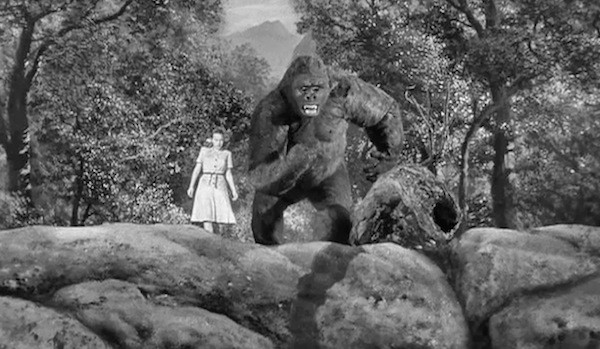


No comments:
Post a Comment